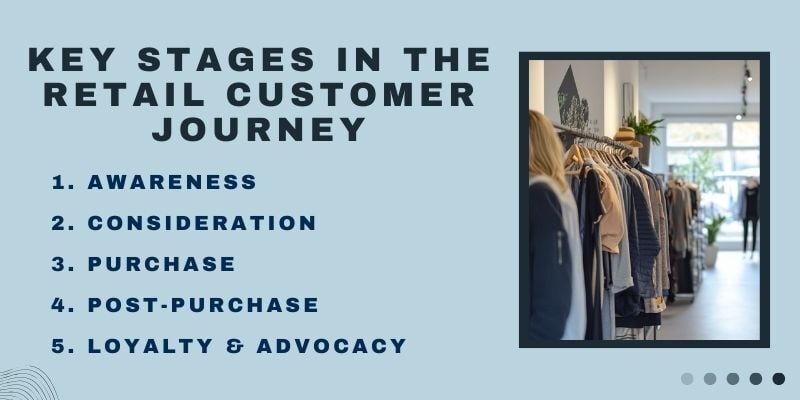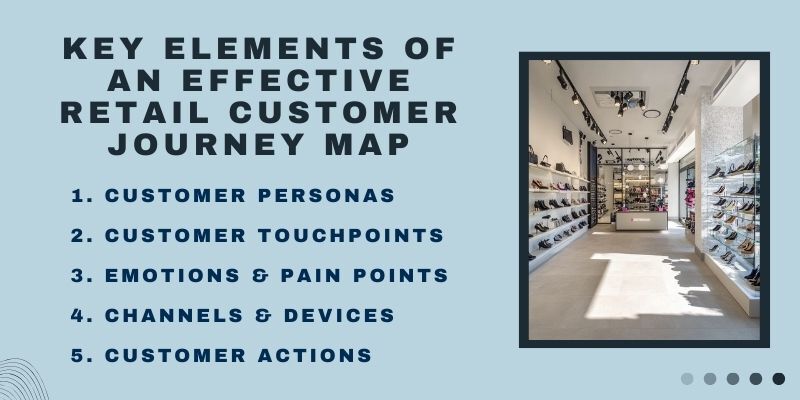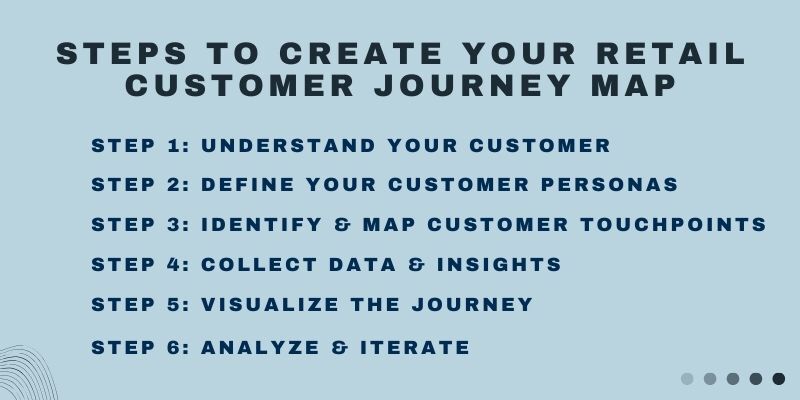Retail today is more competitive than ever, and customer expectations continue to rise. A single poor experience can deter shoppers from a brand, while a positive one can turn them into long-term advocates.
To succeed in this environment, retailers need a clear understanding of how customers interact with their brand at every stage. This is where a retail customer journey map becomes essential.
A retail customer journey map is a visual framework that shows the path customers take from the moment they first discover a brand to their purchase.
It highlights each touchpoint, from marketing channels to in-store experiences, allowing businesses to spot friction points and uncover opportunities. By mapping the journey, retailers can deliver more personalized experiences, improve service, and build loyalty.
In this blog, we will explore how to create an effective retail experience strategy, its key stages, and how it drives stronger business outcomes.
What is a Retail Customer Journey Map?
In retail, every interaction matters. From the moment a shopper notices a brand’s promotion online to the time they walk out of a store with a purchase, their experience leaves a lasting impression.
A retail customer journey map is a way for businesses to capture this entire path step by step. It is more than a diagram. It provides a structured view of how customers discover, evaluate, purchase, and even return for repeat business.
For retail leaders, this map is a decision-making tool. It highlights where customers may drop off, feel frustrated, or remain loyal.
For example, a long checkout line might push a shopper to abandon their cart, while a smooth click-and-collect service can strengthen repeat visits.
That is why retail customer journey mapping has become essential for brands looking to improve customer experience in retail stores and create seamless engagement across every touchpoint.
Research from Deloitte indicates that consumers spend 37% more with brands that consistently deliver positive interactions across various channels.
This shows that mapping the journey is not only about improving satisfaction but also about driving measurable business growth.
Why a Customer Journey Map is Essential for Retailers
Picture a store manager scanning the floor at peak hours only to see shoppers abandon carts just before checkout. A thoughtful retail customer journey map pinpoints these friction points so the retailer can take action.
As Jerry Gregoire, former CIO of Dell, says, “The customer experience is the next competitive battleground.” This emphasizes that optimizing every touchpoint is not just a nicety; it is essential to staying ahead in retail.
Recent research from McKinsey reveals that refining the order-to-purchase path can boost customer retention by 5 to 10%, creating a stronger foundation for repeat business.
These figures make a powerful case. Journey mapping is about hard outcomes, not just theory. It helps uncover actual pain points such as long checkout lines or inconsistent online-to-in-store experiences, so retailers can apply improvements where they matter most.
It also supports the creation of personalized experiences. By understanding where digital engagements misalign with in-store behavior, retailers can close those gaps and genuinely improve customer experience.
In short, investing time in mapping the retail customer journey, backed by the right solutions, delivers clarity and guides decisions that build loyalty, drive conversions, and reduce churn.
Key Stages in the Retail Customer Journey

Understanding the customer journey is essential for retailers who want to build long-term relationships. Each stage presents an opportunity to connect, influence, and deliver a positive customer experience.
1. Awareness:
The journey begins when potential buyers become aware of a brand through advertising, social media, or physical retail exposure.
Digital signage and interactive displays play a critical role here. Wavetec’s retail solutions, for example, help brands capture attention at high-traffic locations by presenting dynamic, real-time content that sparks interest.
2. Consideration:
Once aware, customers start evaluating alternatives. This stage is where retail customer behavior mapping becomes vital. Retailers who understand what their customers are researching can create better engagement opportunities.
Digital touchpoints, such as self-service kiosks, allow shoppers to browse product details, compare features, and access promotions instantly, keeping them within the retailer’s ecosystem rather than losing them to competitors.
3. Purchase:
The purchase stage is where seamless execution matters most. Long queues or outdated checkout processes can turn interest into frustration.
By optimizing digital touchpoints in the customer journey, retailers can streamline transactions through solutions such as queue management systems and self-checkout kiosks.
Zara, in collaboration with Wavetec, has implemented advanced self-checkout systems in select stores. These kiosks allow customers to independently complete their purchases, reducing wait times and enhancing the overall shopping experience.
This initiative not only improves efficiency but also aligns with Zara’s commitment to integrating technology for a better in-store experience.
4. Post-purchase:
Customer engagement does not end at checkout. Returns, support requests, and follow-up communication form the foundation of the post-purchase experience.
A smooth returns process supported by self-service kiosks or digital feedback terminals builds trust and reinforces positive sentiment.
5. Loyalty and Advocacy:
At this stage, the goal is to turn satisfied customers into advocates who recommend the brand to others. Loyalty programs integrated with digital platforms encourage repeat visits and long-term relationships.
Wavetec’s customer engagement solutions help retailers gather feedback, personalize rewards, and track behavior patterns, making loyalty initiatives both measurable and effective.
Key Elements of an Effective Retail Customer Journey Map

An effective retail customer journey map does more than outline the buying process. It serves as a strategic guide for retailers to enhance engagement, identify friction points, and deliver a superior retail customer experience across all interactions.
1. Customer Personas
Developing accurate customer personas is the first step. These profiles help retailers understand varying preferences, purchase patterns, and motivations.
By analyzing demographic data, shopping behavior, and feedback, retailers can create detailed personas that guide personalized recommendations, product placements, and marketing strategies, ensuring a more relevant and satisfying customer experience.
2. Customer Touchpoints
Identifying all touchpoints from physical stores and mobile apps to social media and email is critical. A robust omni-channel strategy ensures these touchpoints are connected, consistent, and engaging, reducing confusion and improving overall satisfaction.
3. Emotions and Pain Points
Documenting how customers feel at each stage of their journey highlights areas of frustration, excitement, or hesitation. Recognizing these emotions helps retailers prioritize improvements that address real pain points, whether it is long checkout waits or unclear product information.
4. Channels and Devices
These days, customers engage across multiple devices and channels. Research shows that 94% of B2B respondents consider today’s omnichannel customer experience to be as effective or more effective than before the COVID-19 pandemic.
Mapping these interactions helps retailers maintain a seamless experience across all platforms.
5. Customer Actions
A detailed understanding of customer actions at each stage, such as browsing, comparing, or purchasing, allows retailers to optimize engagement.
Wavetec solutions, including interactive kiosks and digital signage, can influence decisions in real time and guide customers toward completing purchases efficiently.
By combining these elements, retailers can create a journey map that not only visualizes customer behavior but also informs actionable strategies to improve service, engagement, and loyalty.
Steps to Create Your Retail Customer Journey Map

Building an effective retail customer journey map requires a structured, data-driven approach. It is not just a visualization; it is a strategic tool for managing customer journey and enhancing engagement across every touchpoint.
Step 1: Understand Your Customer
Begin by gathering insights through surveys, customer interviews, and analytics. Observe actual behavior in-store and online to uncover motivations, preferences, and pain points that might not appear in standard sales data.
Consider tracking metrics like dwell time in different store zones, abandoned cart rates, and frequency of online engagement. These insights help design meaningful interactions and guide decisions throughout the retail marketing journey.
Step 2: Define Your Customer Personas
Segment customers based on demographics, purchasing behavior, and preferences. Create detailed customer personas that include goals, challenges, and preferred channels.
For instance, a tech-savvy shopper might respond better to mobile app promotions, while a value-focused customer may rely more on in-store discounts. Clearly defined personas guide personalized communications and operational decisions.
Step 3: Identify and Map Customer Touchpoints
Catalog every interaction a customer has with the brand, from website visits and app notifications to in-store kiosks and customer service calls. Map the frequency, duration, and impact of each touchpoint.
Integrating digital solutions, such as interactive kiosks or dynamic signage, can actively influence decisions, reduce friction, and provide insights into how customers move between channels.
Companies that excel in omnichannel engagement experience an average annual revenue growth of 9.5%, compared to just 3.4% for businesses with less effective strategies, highlighting the tangible benefits of connecting every customer touchpoint.
Step 4: Collect Data and Insights
Leverage analytics platforms and real-time inputs from kiosks, queue management systems, and digital displays to gather actionable insights.
This data collection of customers reveals trends such as peak shopping hours, popular product categories, and bottlenecks in checkout processes. Consistent monitoring ensures your journey map remains aligned with changing customer behavior.
Step 5: Visualize the Journey
Transform raw data into a clear visual map that illustrates the customer’s path across all touchpoints. Highlight moments of engagement, decision-making, and potential frustration.
Visualizations help teams quickly identify where improvements are most needed and facilitate alignment between marketing, operations, and customer service on strategic priorities.
Step 6: Analyze and Iterate
Regularly review the journey map to identify gaps and opportunities for optimization. Use customer feedback, conversion metrics, and operational data to refine strategies.
Collaboration across departments ensures actionable changes, whether it’s optimizing checkout processes, enhancing loyalty programs, or adjusting digital content.
Iterative updates make the map a living tool that continuously supports the optimization of digital touchpoints throughout the customer journey.
Common Pitfalls to Avoid When Mapping the Customer Journey
Retailers often invest time and resources into creating a customer journey map, but missteps can undermine its value.
One common mistake is focusing too much on internal processes rather than the customer’s actual experience. A map should reflect how customers feel, decide, and interact, not just how operations run behind the scenes.
Overcomplicating the map with excessive detail can also dilute insights. Including every minor step may seem thorough, but it can make the map confusing and harder to act upon.
Instead, prioritize key touchpoints where interventions can have a meaningful impact on the customer experience.
Ignoring emotional aspects is another frequent error. How customers feel, whether frustrated by long waits or delighted by personalized service, can strongly influence loyalty and satisfaction.
As Bill Gates, Co-founder of Microsoft, highlights, “Your most unhappy customers are your greatest source of learning.” Capturing these emotions ensures journey mapping addresses pain points, drives improvement, and enhances customer satisfaction.
Finally, mapping a single journey for all customers overlooks the diversity in retail behavior. Segmenting by customer personas allows retailers to identify different needs and customize solutions.
By avoiding these pitfalls, retailers can ensure their journey maps remain focused, actionable, and centered on what truly matters: the customer.
How to Use Your Customer Journey Map to Drive Retail Strategy
A customer journey map is more than a static document; it is a strategic guide that informs decisions across marketing, operations, and sales.
Retailers can use these insights to optimize retail operations, improve service, and customize experiences to different customer segments.
Personalizing marketing campaigns becomes easier when the map highlights which segments respond best to specific promotions or messaging.
For example, a tech-focused shopper may prefer app-based offers, while a value-conscious customer may respond more to in-store discounts or bundled deals.
Customer service can be strengthened by gathering feedback, enabling staff to address issues immediately, reducing wait times, and ensuring smooth in-store experiences.
Real-time feedback enhances customer service quality, allowing operational teams to adapt strategies based on actual shopper behavior quickly.
The journey map also uncovers pain points in product offerings. Retailers can refine assortments, adjust inventory, or reconfigure displays to better meet customer expectations, ensuring the right products are available at the right moment.
According to McKinsey, companies that implement omnichannel transformations report revenue growth of 5-15% and improvements in cost-to-serve efficiencies of 3-7%.
This shows how understanding and acting on the customer journey improves satisfaction while supporting overall business growth.
By using a customer journey map to guide marketing, service, and operational decisions, retailers can enhance engagement, increase conversions, and create a seamless, satisfying shopping experience across every touchpoint.
Tools and Resources for Creating a Retail Customer Journey Map
Creating an effective retail customer journey map requires a combination of planning, data collection, and visualization. Several tools can help retailers map customer behavior accurately and turn insights into actionable strategies.
An example of this is Kohl’s, which deployed Wavetec’s UNO-Q solution across multiple stores. By monitoring real-time queue lengths and integrating customer feedback, Kohl’s was able to adjust staffing, optimize checkout lanes, and provide faster, more personalized service.
This approach not only reduced wait times but also generated insights for improving the overall customer journey.
Platforms like Smaply, Lucidchart, and Miro provide intuitive templates and collaborative features, allowing teams to design clear journey maps and share them across departments.
Collecting accurate data is critical. Retailers can gather insights through customer interviews, surveys, and observational studies, which provide a qualitative understanding of shopper motivations and frustrations.
Complementing this, analytics platforms such as Google Analytics and Hotjar reveal quantitative patterns like browsing behavior, time spent on pages, and conversion trends. Integrating these datasets ensures a holistic view of the customer experience.
Self-service kiosks contribute to journey mapping by collecting real-time data on customer interactions, preferences, and behaviors in-store.
These insights allow retailers to track engagement, measure satisfaction, and identify friction points at key touchpoints, making the journey map both dynamic and precise.
By combining the right tools, data collection methods, and in-store technologies, retailers can create a customer journey map that reflects real-world behavior, highlights opportunities for improvement, and supports strategies that enhance overall customer satisfaction.
Conclusion
Customer journey mapping gives retailers a clear view of how shoppers experience their brand at every stage. It helps identify friction points, track customer behavior, and improve satisfaction.
Insights from the map can guide marketing decisions, streamline operations, and make interactions more relevant for different customer segments.
Journey mapping is not a one-off task; it requires regular updates as customer needs and shopping patterns change. By starting the process, retailers can better understand their customers, address pain points, and enhance loyalty.
Continuous attention to the journey ensures that each interaction adds value, making shopping easier and more enjoyable while supporting stronger business performance.
BOOK A FREE DEMO





